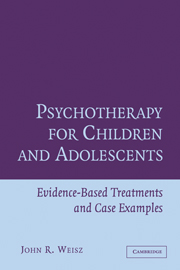Book contents
- Frontmatter
- Contents
- Preface
- SECTION A GENERAL INTRODUCTION
- SECTION B TREATMENTS FOR FEARS AND ANXIETY
- SECTION C TREATMENTS FOR DEPRESSION
- SECTION D TREATMENTS FOR ATTENTION DEFICIT/HYPERACTIVITY DISORDER
- Introduction to Section D: The Case of Kevin and Treatments for Attention Deficit/Hyperactivity Disorder
- 6 Using Behavioral Parent Training to Treat ADHD
- 7 Behavioral Programs for ADHD in Classroom and Camp Settings
- SECTION E TREATMENTS FOR CONDUCT PROBLEMS AND CONDUCT DISORDER
- SECTION F CONCLUSION
- References
- Author Index
- Subject Index
6 - Using Behavioral Parent Training to Treat ADHD
Published online by Cambridge University Press: 06 July 2010
- Frontmatter
- Contents
- Preface
- SECTION A GENERAL INTRODUCTION
- SECTION B TREATMENTS FOR FEARS AND ANXIETY
- SECTION C TREATMENTS FOR DEPRESSION
- SECTION D TREATMENTS FOR ATTENTION DEFICIT/HYPERACTIVITY DISORDER
- Introduction to Section D: The Case of Kevin and Treatments for Attention Deficit/Hyperactivity Disorder
- 6 Using Behavioral Parent Training to Treat ADHD
- 7 Behavioral Programs for ADHD in Classroom and Camp Settings
- SECTION E TREATMENTS FOR CONDUCT PROBLEMS AND CONDUCT DISORDER
- SECTION F CONCLUSION
- References
- Author Index
- Subject Index
Summary
Because children with ADHD often have difficulty monitoring and managing their own behavior and following through with plans, a series of one-hour visits with a psychotherapist may not be so helpful to them. Insights gained and skills practiced with the therapist may be forgotten soon after the child returns to real life. Even if the insights are recalled, their power to govern behavior may be swamped by the force of impulses and distracting events. As noted in the introduction to this section, ADHD may not involve deficits in insight and understanding so much as deficits in performance that have their impact on child functioning in important life settings. What may be needed to address these performance deficits for the ADHD child is intervention that is located in those life settings, present on a daily basis, and monitored and managed by significant others in the setting. In one of the most extensively studied approaches to treatment, those significant others are the child's parents, and the setting is home.
Most approaches to behavioral parent training involve helping parents learn to design and implement contingency management programs. A number of such programs have been used with parents of youths diagnosed with ADHD. A common sequence is that parents are assigned readings on behavioral principles, they have a series of group sessions to learn and practice standard behavioral procedures, and they apply the procedures with their child and receive corrective feedback until the child's behavior shows desired change.
- Type
- Chapter
- Information
- Psychotherapy for Children and AdolescentsEvidence-Based Treatments and Case Examples, pp. 172 - 208Publisher: Cambridge University PressPrint publication year: 2004



